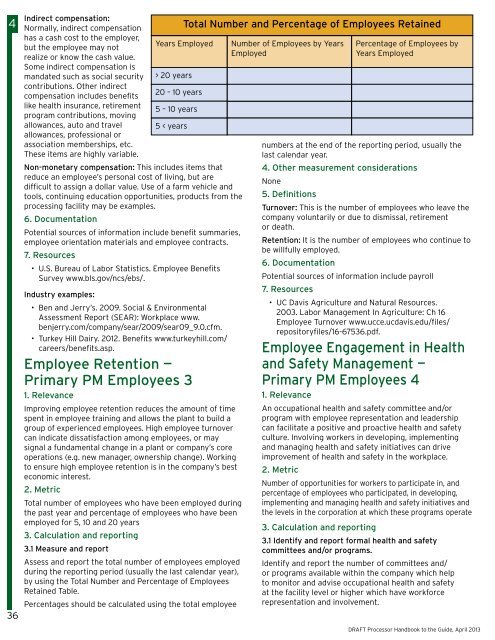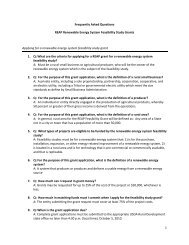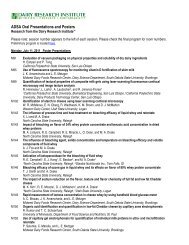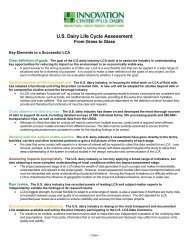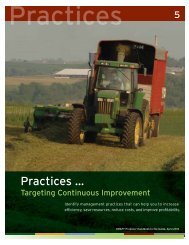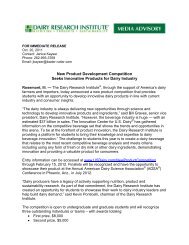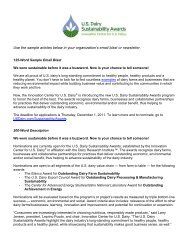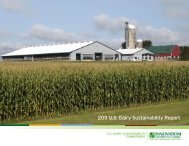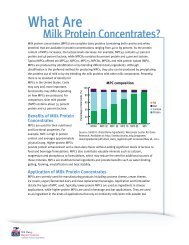Processor Handbook - Innovation Center for US Dairy
Processor Handbook - Innovation Center for US Dairy
Processor Handbook - Innovation Center for US Dairy
Create successful ePaper yourself
Turn your PDF publications into a flip-book with our unique Google optimized e-Paper software.
4<br />
36<br />
Indirect compensation:<br />
Normally, indirect compensation<br />
has a cash cost to the employer,<br />
but the employee may not<br />
realize or know the cash value.<br />
Some indirect compensation is<br />
mandated such as social security<br />
contributions. Other indirect<br />
compensation includes benefits<br />
like health insurance, retirement<br />
program contributions, moving<br />
allowances, auto and travel<br />
allowances, professional or<br />
association memberships, etc.<br />
These items are highly variable.<br />
Non-monetary compensation: This includes items that<br />
reduce an employee’s personal cost of living, but are<br />
difficult to assign a dollar value. Use of a farm vehicle and<br />
tools, continuing education opportunities, products from the<br />
processing facility may be examples.<br />
6. Documentation<br />
Potential sources of in<strong>for</strong>mation include benefit summaries,<br />
employee orientation materials and employee contracts.<br />
7. Resources<br />
• U.S. Bureau of Labor Statistics. Employee Benefits<br />
Survey www.bls.gov/ncs/ebs/.<br />
Industry examples:<br />
• Ben and Jerry’s. 2009. Social & Environmental<br />
Assessment Report (SEAR): Workplace www.<br />
benjerry.com/company/sear/2009/sear09_9.0.cfm.<br />
• Turkey Hill <strong>Dairy</strong>. 2012. Benefits www.turkeyhill.com/<br />
careers/benefits.asp.<br />
Employee Retention —<br />
Primary PM Employees 3<br />
1. Relevance<br />
Improving employee retention reduces the amount of time<br />
spent in employee training and allows the plant to build a<br />
group of experienced employees. High employee turnover<br />
can indicate dissatisfaction among employees, or may<br />
signal a fundamental change in a plant or company’s core<br />
operations (e.g. new manager, ownership change). Working<br />
to ensure high employee retention is in the company’s best<br />
economic interest.<br />
2. Metric<br />
Total number of employees who have been employed during<br />
the past year and percentage of employees who have been<br />
employed <strong>for</strong> 5, 10 and 20 years<br />
3. Calculation and reporting<br />
3.1 Measure and report<br />
Assess and report the total number of employees employed<br />
during the reporting period (usually the last calendar year),<br />
by using the Total Number and Percentage of Employees<br />
Retained Table.<br />
Percentages should be calculated using the total employee<br />
Total Number and Percentage of Employees Retained<br />
Years Employed<br />
> 20 years<br />
20 – 10 years<br />
5 – 10 years<br />
5 < years<br />
Number of Employees by Years<br />
Employed<br />
Percentage of Employees by<br />
Years Employed<br />
numbers at the end of the reporting period, usually the<br />
last calendar year.<br />
4. Other measurement considerations<br />
None<br />
5. Definitions<br />
Turnover: This is the number of employees who leave the<br />
company voluntarily or due to dismissal, retirement<br />
or death.<br />
Retention: It is the number of employees who continue to<br />
be willfully employed.<br />
6. Documentation<br />
Potential sources of in<strong>for</strong>mation include payroll<br />
7. Resources<br />
• UC Davis Agriculture and Natural Resources.<br />
2003. Labor Management In Agriculture: Ch 16<br />
Employee Turnover www.ucce.ucdavis.edu/files/<br />
repositoryfiles/16-67536.pdf.<br />
Employee Engagement in Health<br />
and Safety Management —<br />
Primary PM Employees 4<br />
1. Relevance<br />
An occupational health and safety committee and/or<br />
program with employee representation and leadership<br />
can facilitate a positive and proactive health and safety<br />
culture. Involving workers in developing, implementing<br />
and managing health and safety initiatives can drive<br />
improvement of health and safety in the workplace.<br />
2. Metric<br />
Number of opportunities <strong>for</strong> workers to participate in, and<br />
percentage of employees who participated, in developing,<br />
implementing and managing health and safety initiatives and<br />
the levels in the corporation at which these programs operate<br />
3. Calculation and reporting<br />
3.1 Identify and report <strong>for</strong>mal health and safety<br />
committees and/or programs.<br />
Identify and report the number of committees and/<br />
or programs available within the company which help<br />
to monitor and advise occupational health and safety<br />
at the facility level or higher which have work<strong>for</strong>ce<br />
representation and involvement.<br />
DRAFT <strong>Processor</strong> <strong>Handbook</strong> to the Guide, April 2013


